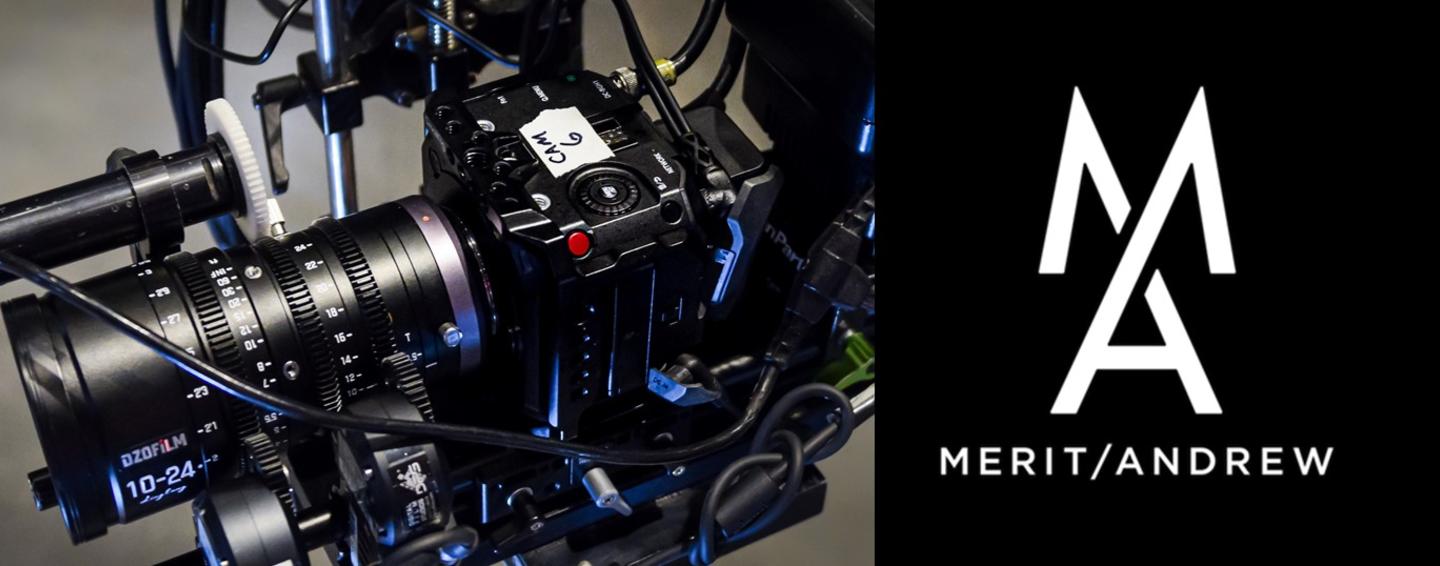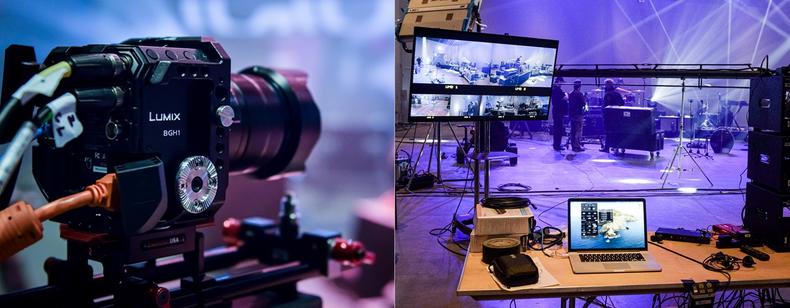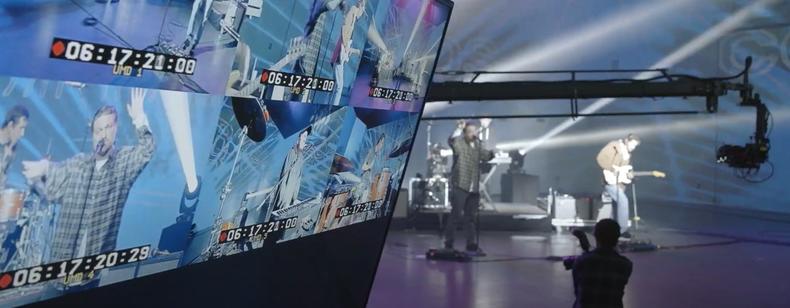LUMIX Pro Case Study: Multicamera Concert with the LUMIX BGH1

LUMIX Pro case study: Multicamera concert with the LUMIX BGH1
See how the BGH1 box camera was used during the 2021 Consumer Electronics Show in a 6-camera live concert presentation featuring the band Cold War Kids.
The pandemic has changed so many things in our lives, including the way that trade shows like the Consumer Electronics Show (CES) are conducted. Technics Audio wanted to do something truly special for CES: provide a livestreamed concert experience featuring the band Cold War Kids. With a wireframe of their plan, Technics contacted the creative content studio Merit/Andrew to help bring their vision to life.
Merit/Andrew, a creative content studio focused on crafting stories and premium content, was able to combine their experience with live events with more traditional cinematic projects to bring this Panasonic event to life. Merit/Andrew had the idea of offering an immersive experience that would allow the viewer to select the camera angle they wanted to see. For example, if you’d like to see just the drummer, no problem! Want to view the jib camera? Sure!
“Our challenge was to create an immersive experience with multiple cameras and give the audience the ability to choose the way they want to view the concert. We needed a versatile camera that allowed for several different use scenarios – from mounting on the stage, to outfitting with a zoom lens, and putting it on a jib. We needed to make sure that we could capture several different angles without any image quality issues. It needed to feel seamless as we cut from one angle to another," said Caroline Scott, Executive Producer at Merit/Andrew.
With the plan of giving the audience control over what camera they watch, Merit/Andrew knew they would need two small cameras with high image quality that could place inconspicuously on stage with the band. They came to LUMIX to see if we had a solution, and sure enough, the new BGH1 box camera would be ready in time for their shoot. So, the BGH1 would be the cameras for the drummer and the keyboard player, and other production cameras would be used for the rest of the angles. Or so everyone thought.
When Merit/Andrew and their production team looked at the features of the BGH1, they asked if they could just shoot the whole project with it. And why not? After all, the BGH1 has everything a live production would need: dual monitor outputs (HDMI to feed the in-camera monitor and SDI to the switching system); Time Code and Genlock for sync of the cameras; dual SD card slot for redundancy of recording (more on that in a moment); and the icing on the cake, excellent image quality – good enough for a Netflix production.
Planning the shoot
The Cold War Kids project was going to merge live event production with a cinematic feel – think “live concert meets music video.” This required the expertise of both live event and cinematic production. Caroline Scott of Merit/Andrew was tasked with selecting the team that would handle all production and post-production. Once the concept was finalized, Caroline contracted with Warren Tash of Tashman LA for system design.
Warren was most concerned with redundancy since this would be a live performance with no opportunity for second and third takes. The system consisted of six BGH1 cameras; six Blackmagic Design Video Assist Monitor recorders, each connected via HDMI; six AJA Ki Pro recorders connected to the BGH1 via HD-SDI that was sent to a Decimator 12X1 SDI multi-view so the director can see all 6 cameras at once while recordings are made in each BGH1; A ProRes file in each BMD Video Assist; and a ProRes file in each Ki Pro recorder. Five of the cameras also had ethernet connected via a PoE+ switch to provide camera control and power to the cameras. This allowed these five cameras to be fully controlled via the LUMIX Tether for Multicam App, so that all settings could be sent from one location, and recording could be triggered all at once. The jib camera was the only one that was powered via battery solution and controlled by the jib operator. The jib camera received a DZO 10-24mm T2.9 cine lens with remote follow focus and zoom control.
As Warren Tash explained in a recent LUMIX live session, “These cameras were all power-over-Ethernet, so we set up one profile on the computer and then cut and pasted that profile to all the cameras. We then hit a button and – bang! – they all matched. It’s so easy.”
With all the live event considerations sorted, it was time to get the DoP, Michael Rizzi, involved to create the look and feel of the final images. Rizzi knew he wanted a wide-angle lens on the jib, and he needed something that could be easily integrated with a standard FIZ (Focus, Iris, Zoom) system. It was a natural to look at Micro Four-Thirds lenses to cover the angle needed and DZO offered a compact 10-24mm lens with cine gearing and a T2.9 aperture. With a little adjustment for back focus the DZO was ready to go. The rest of the cameras all worked with several different lenses. The keyboards and drums got Leica 8-18mm F2.8-F4 lenses; the tripod operated cameras got Leica 12-60mm f2.8-F4 lenses; and one BGH1 on a tripod got a Leica 50-200mm F2.8-F4.
Because of the complex nature of the lighting – Panasonic Laser Projection, an entire lighting rig, plus the fact that the viewer could select any angle at any time – it was decided that the cameras couldn’t adjust their exposures during the production, to avoid risking blown-out images during some scenes. Instead they used a Log workflow (V-Log-L to be exact) to help gain some extra dynamic range for the post-production, to ensure the best possible image would be presented. A standard Panasonic V-Log to REC709 LUT was loaded into all the BMD Video Assists so that V-Log-L could be recorded. A proper preview could be seen on the monitors. Even the Ki Pro recorders got fed a LUT so that the director could see a near-finished image.
Preparation and planning yields near-perfect results
With all the cameras in place, matched, and ready to shoot, it was time for Cold War Kids to do what they do best: provide an energetic performance. That can be tough to do with no live audience, but they pulled it off brilliantly. Many of the production team felt a little spoiled since they got to see live music for the first time in a year. With the performance wrapped and the venue cleared out, it was time to cut a 6-camera edit with a separate audio track (don’t forget the redundant recordings; a potential of 18 video tracks). The editor for this project uses an Avid bay and found no problems with any of the files, ultimately working with the BMD ProRes files. The Time Code really helped to keep audio and video in sync. The only real hiccup was the DZO lens, since the color is a little different than all the Panasonic/Leica Lenses; that required a little tweaking to get it all done. A couple of passes by the Technics team and we had the approval that all looked great and we could publish. Amazingly, the edit came together in around 1 week, with time to spare.
Caroline Scott of Merit/Andrew confirmed during a LUMIX Live session: “We left Las Vegas on Friday morning, arrived in LA that afternoon with the footage, and had our rough cut done by Monday.”
In the end, Technics was pleased with the results, and LUMIX was happy that the BGH1 pulled this off without a hitch and that the concert looked great. But don't take our word for it – follow the links to see the finished edit, the BTS, and all the individual camera angles (drums, keyboard, lead singer, guitar, bass, jib). To learn more about the production, check out our YouTube LUMIX Live presentation and hear from the production team. We want to thank Technics, Caroline, Warren, Rizzi, the entire Merit/Andrew team, and of course Cold War Kids for allowing LUMIX to be a part of this terrific project.
For more information on Merit/Andrew, please visit their website https://meritandrew.com/.

